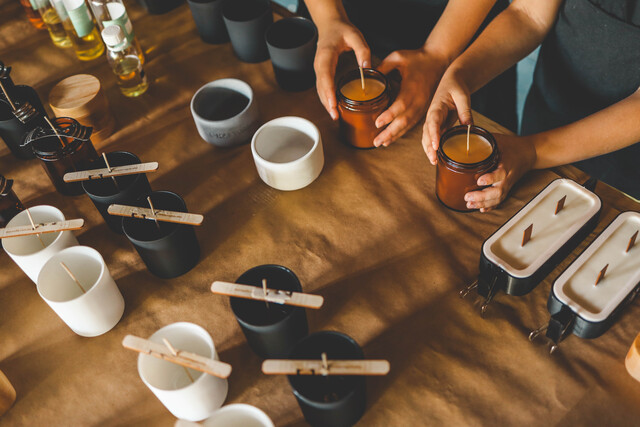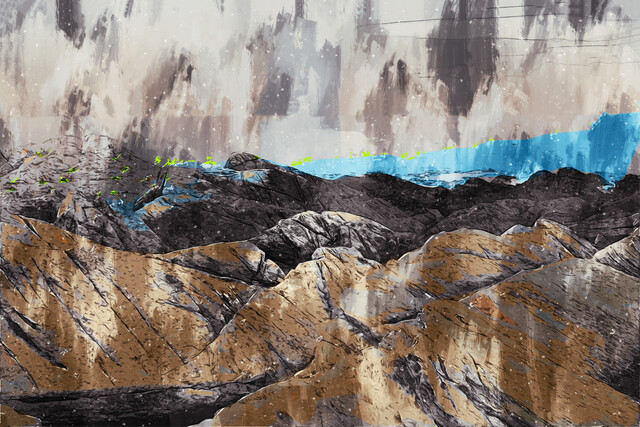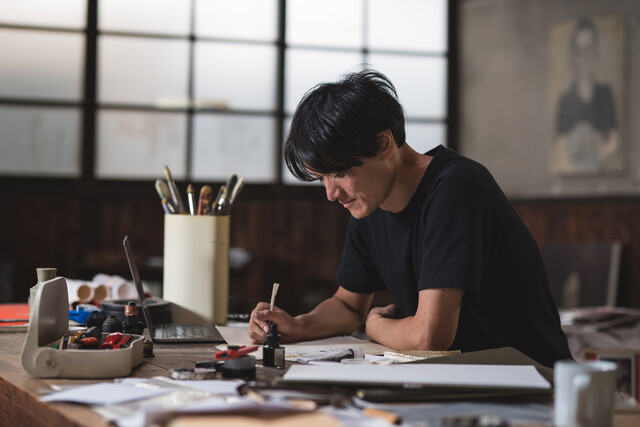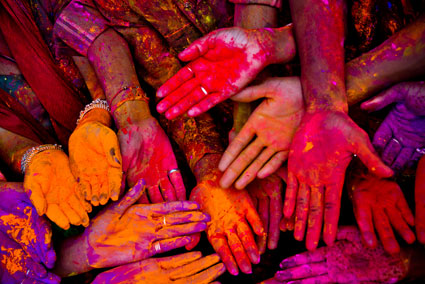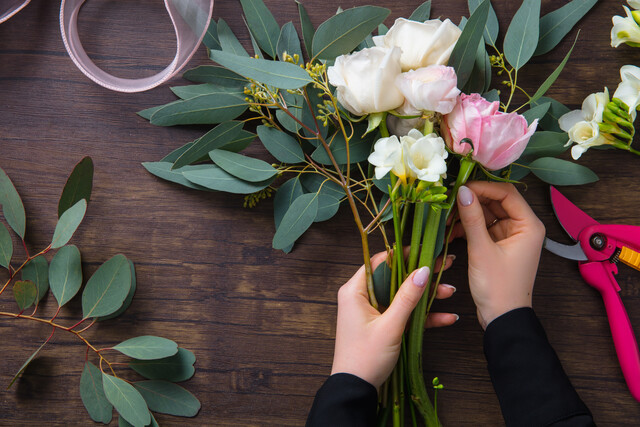Did you know that everything in knitting is comprised of two basic stitches? It is-the knit stitch and purl stitch. These two stitches, and a few other techniques, make up every piece of knit fabric you see and make.
Before we jump in I want to share some basic terminology and the two main styles of knitting, which I'll demonstrate for both the knit and purl stitch.
Basic Terminology
Skein of Yarn: As shared above, yarn comes in skeins, hanks, balls, etc. I will reference "skein of yarn" it is the yarn you are working with at this time.
Working Yarn: The yarn which comes directly from your "skein of yarn".
Slip Knot: A sliding knot created to start your knitting and it makes your first stitch.
Tail End: This is the yarn opposite your skein of yarn.
Stitch: A loop of yarn resulting from one pass or moment[1].
Row: Working across the stitches on your needle once.
Cast On: Adding stitches on the needle.
Bind Off: Removing stitches off the needle.
Knitting Styles
This article will demonstrate two styles of knitting: Continental and English. The resulting stitches are the same. The difference is found in the way you hold and maneuver the working yarn.
Continental Method: The working yarn is drawn with the left hand. This method is also called the European method and the picking method.
English Method: The working yarn is drawn with the right hand. This method is also called the throw method and the American method.
YEAH! You have just purled.
You can continue to purl through the end of your work.
Demonstration #5: Purl Stitch
In the fifth video you will learn:
- How to create the purl stitch using the English Method-the right hand carry method; and
- How to create the purl stitch using the continental method-the left hand carry method.
Next - onto binding off! (Can't you believe it? You're knitting!)
TRY IT: Now is a great time to continuing to practice what you've learned. I'll ditto what was shared before, try both methods of the purl stitch on the same swatch (sample piece). Work at least 5 or 6 rows. Move on once you feel comfortable.
Basic Combinations and Reading Instructions
Basic Combinations of Knit and Purl Stitches
Rows of Knitting
Rows of Purling
Basics of Reading Knit Instructions
Knitting instructions are presented in many forms. You have visual and written. You also have charted.
Written Instructions
Written instructions given row by row. The direction are read similar to you reading this passage, left to right and executed in the order provided.
For example, here are a few lines for instructions for the Sampler Dish Cloth provided in Lesson ???:
Row 5: Knit.
Row 6: K4 sts, p to last 4 sts, k4 sts.
Row 17: K4 sts, *p1, k1; rep from* (seed stitch-SS) to last 4 sts, k4 sts.
What does it say?
Row 5: Knit. - Knit all stitches
Row 6: K4 sts, p to last 4 sts, k4 sts. - Knit the first four stitches. Purl across the piece to the last four stitches. Knit the last four stitches.
Row 17: K4 sts, *p1, k1; rep from* (seed stitch-SS) to last 4 sts, k4 sts. - Knit the first four stitches. Purl one stitch. Knit one stitch. Repeat from *, which is purl one, knit one and continue the repeat to the last four stitches. Knit the last four stitches.
Charted Instructions
Knit charts are pictorial representations of the knitted project to be made. There are some key distinctions to being successful at chart reading.
1. Charts for flat knitting have odd numbers on the right-hand side of the chart and even numbers on the left-hand side.
2. Each row on the chart represents a row of knitting.
3. Each square on the chart represents a single stitch.
4. Reading the chart begins at the bottom right-hand corner and is read from right to left. Then the second row is read left to right. You are essentially reading from bottom to top in a zig-zag pattern.
Stitch Combinations with Written & Charted Instructions
Should you decide to visit your local bookstore or library and browse the knitting books you would find many stitch dictionaries and encyclopedias. For this class we want you to have a solid basis to began (and complete) most basic knit projects.
Here are some of the basic combinations used in knitting. The combinations are offered with the written and charted directions.
Demonstration #7: Pattern Reading
In the seventh video you will learn:
How to read a basic knitting pattern in written instructions; and
How to read a basic knitting pattern in charted instructions.
Other Techniques
One of the most interesting things about knitting is that when two knitters follow the same pattern, the results are not exactly the same. This has nothing to do with ability and everything to do with choice. It is probably why knitting, as a hobby, is so well liked, it can be personalized with:
- Yarn selection,
- Color choices,
- Needle size and type, and
- Much more.
We did not want to leave you without mentioning some other techniques not covered in detail. However we'd like to share general information on them.
Check Your Gauge
Now that your sample piece is finished, let's look at your gauge.
Flatten your sample piece.
Place a tape measure or ruler next to piece.
Count the stitches per inch. Count the rows per inch.
Write the number here _______ S Write the number here ________ R
Does it match the gauge on the yarn wrapper?
Did you use the correct needle size for your yarn selection?
If you have MORE stitches per inch than the yarn wrapper you are a tight knitter.
If you have LESS stitches per inch than the yarn wrapper you are a loose knitter.
TIGHT KNITTERS: If it is just one stitch per inch that you are off, try the next size needle up. Example: if you used size 8 needles and your piece has too many stitches per inch, try a 9. Cast on 10 stitches and knit about 8 or 9 rows. Check gauge again.
LOOSE KNITTERS: You have two options. Try again with the same size needles and make sure your yarn is pulled a little snugger with each stitch. This is adjusting your tension. OR, you may elect to drop a needle size. Example: if you used sized 8 needles and your piece does not have enough stitches per inch, try a size 7. Cast on 10 stitches and knit about 8 or 9 rows.
After adjusting your tension or your needle size recheck your gauge you do not necessarily have to bind-off to do this. You may lay your sample on a flat surface and measure with the tape as you did the finished piece.
If you are several stitches off in either direction, double check your needles to make certain you have the correct size. An inexpensive needle gauge tool can be purchased if your needles are not marked.
How to Change Color
Once you learn to knit, you will want to incorporate your own sense of style, beginning with color. To change colors, simply change your working yarn to another color. It is really that easy.
A basic striped pattern is achieved by alternating rows of knitting with two or more colors. This can be done an infinite number of times. You can use two colors or several. You can knit one row per color or knit several in one and a single in another. It is recommended, in the beginning, that you stick with the same type of yarn - weight, gauge and manufacturer when learning to change colors.
Give it a try! Once you get the hang of knitting and purling try switching it up to add variety and color.
Free Form Knitting
Free Form Knitting (not following a pattern, a chart or any instructions) can be a great way to use up left over yarns and fibers. You can mix stitches, yarns, and never worry about the needle size. When you are finished, you might have a little work of art.
Free form knitting is a great stress reliever as well as a fun way to see what you can do.
Avoiding Problems
Often when you first learn to knit, you are overwhelmed with so many tasks. Just concentrate on knitting and purling, and perfecting those two stitches. As you become more experienced you will experience problems - even talented knit designers have problems.
Use the correct tools: It is often a good idea to practice your stitches with the correct yarn and needle size - nothing is more frustrating than trying to do something without the right tools.
Use the correct yarn: Some decorative stitches will not work with tiny needles, very thin yarn or even variegated yarns - they just can't be seen. Others cannot be done with heavy yarn and thick needles.
Use the correct gauge: This is combination of correct tools and matching yarn size.
Tension: Loosen up your grip on the needles. Your experience will move along more smoothly if you use no tension. This also takes practice. Hold the needles comfortably in your hands. If you knit for fifteen minutes, your hands should not be acting like you have just worked out. Tight knitting makes your finished fabric "sag". The yarn becomes so stressed that it loses its resilience - the entire purpose of knitting.
Dye Lots: Buy all of your yarn for one project at the same time. There are dye lots (the color applied to the raw fiber) for each skein of yarn. Those created at the same time have the same dye lot numbers. There are minute differences between the dye lots, but enough to make an entire project flawed. Don't risk it.
No-more-Tangles: Try to keep your yarn in a ball or its original skein. It will make your knitting go more smoothly. No one wants to sit down to relax and find a tangled mess in the knitting bag.
Dropped Stitches: A Drop Stitch is such as sad event. It can be fixed however. Keep a crochet needle close by to assist in picking them up if it is straight knitting or purling. If it is in a decorative stitch, you are probably going to have to tink or frog your work.
Needle Yanking: Lots of new knitters have a tendency to pull the needles apart. This pulls the yarn with it and creates tension in the adjacent stitches, and an uneven result. It is a popular problem because knitters like to look at what they have done. Try to be patience and wait until the end of a row to see what you have accomplished.
Tinking: This is art of removing mistakes. You can unravel your work by pulling the yarn out, but this makes picking up the stitches that remain, difficult. Tinking requires that you stick the left hand needle into the row below, and then pull on the yarn. This will put the stitches on the needle and help to insure that none are dropped. This takes a little practice.
Frogging: This is the art of completely ripping out your work. You simply remove it from the needles completely and "rip it". Make sure that don't get carried away and complete undo everything.
Curling: Not the sport. If you are making a scarf, you can KPKP the first four stitches and PKPK the last four stitches to make it lay flat. Curling at the ends of a knit piece for a sweater or a sleeve that will be in a seam, doesn't affect the finished piece. The curl will disappear when it gets assembled.
Extra, Extra: Stitches? There are several reasons for extra stitches. Check to make sure your working yarn is not "stuck" on the working needle. This yarn can get in the way, look like a stitch and get knit right into the project with no warning. Occasionally, the yarn gets split by the needle either at the very start or very end of the stitch. Simply undo the stitch to fix this condition. A third cause of extra stitches is that the knitter accidentally picks up the "bar" or the yarn that is between the knit stitches and carries it on the working needle where it becomes part of the project. Extra stitches will completely upset a pattern of stitches - it will be thrown off by the number of extra stitches. The only remedy for this is to unravel back to the picked up stitch.
Demonstration #8: Other Techniques
In the eight video you will learn:
- How to read your knitted work; and
- How to change color or add a new skein of yarn;
REMEMBER: The more you knit the better you'll get. Trying different yarn types, new needles and challenging project will help you grow as a knitter. Mishaps and issues come with progress. Take them all in stride and know it is all part of the process.





